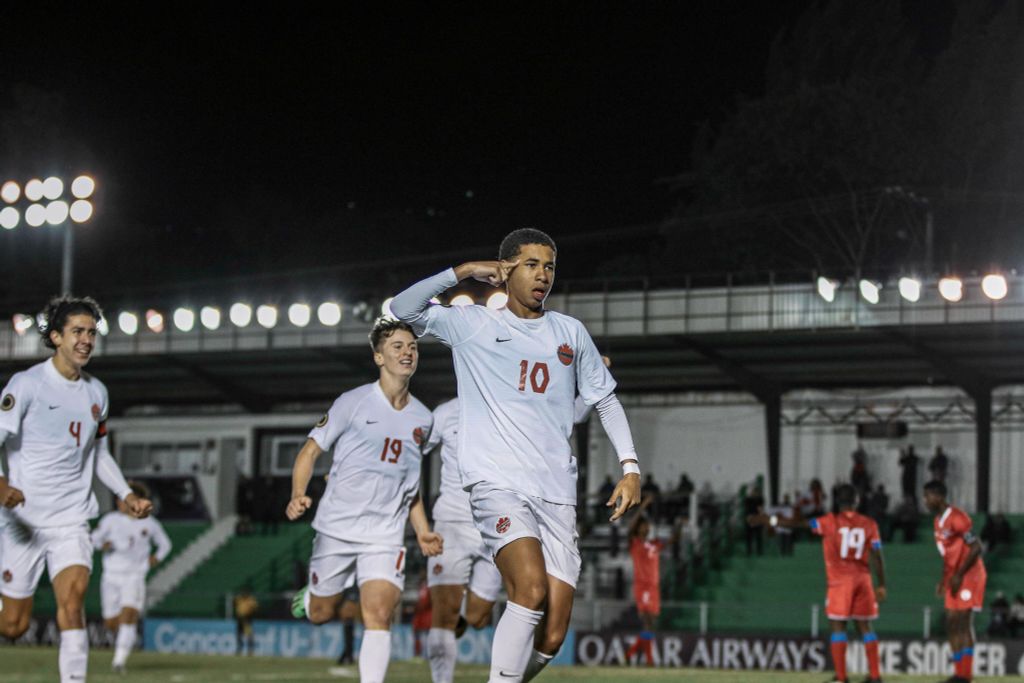Three takeaways from the CanM17's performance at the U17 CONCACAF Championships

They might have come up short of their ultimate goal, but they took care of some important business along the way.
For a second tournament in a row, the U17 Canadian Men’s National Soccer Team is heading to the U17 World Cup, as they beat Puerto Rico 3-0 in the quarter-finals of the CONCACAF U17 Championships last week to secure a top 4 finish, snatching the qualifying berth that comes with it.
That means after missing out on the 2015 and 2017 editions of that tournament, Canada will head to its second consecutive U17 World Cup, and eighth overall, when they make the trek down to Peru later this year.
There, they’ve got a tall task ahead of them, as they look to progress from the group stages for the first time in their history, so for now, they’ll look to use the next nine or so months to prepare for that.
During that time, they’ll look to build off what was overall a solid tournament for the group. In the end, they were unable to make the final, as they fell to the US in the semi-finals (following an earlier defeat to the States in the group stages), but otherwise won all of their matches.
For a team that hasn’t had much time together, a byproduct of Canada not always being able to hold youth camps, that’s a big plus, and they’ll now look to build off of that as they begin planning for Peru.
Therefore, as they begin those preparations, here’s a look back at what stood out from this tournament.
The defence is more than alright:
After the first game of this tournament, you could be excused if you were a bit worried about Canada’s defensive prospects.
Despite going up a player against Trinidad & Tobago, Canada had to fight tooth and nail to get a result, only narrowly winning 3-2 in the end. To be fair, there wasn’t much that they could do about the goals, which both came off bits of individual brilliance, but at the same time, it was worrying that T&T was able to really put Canada’s defence under pressure for spells.
From that point on, however, Canada then ramped things up a notch defensively. And then some.
In fact, they conceded just three goals in the next five games, all three coming in their two games against the US, keeping three clean sheets across matches against Barbados, Haiti and Puerto Rico, with the latter two coming in the knockout stages.
Not only that, but they did well to mostly limit chances in games, too. Apart from the last US game, where they gave up five shots on target, they kept opponents to three shots on target or less in the other games, doing well to mostly keep them out of dangerous areas.
They did get hit a few times in transition, yes, but that is not a common occurrence for teams at the top level, let alone in a tournament at the U17 age group, where a team like Canada hasn’t had much time to play together, and are at an age where they’re still growing a lot tactically.
Because of that, Canada has a lot to be excited about in that area as they get set for Peru.
Knowing that they’ll be led by their Toronto FC contingent of 16-year-old Chimere Omeze, 16-year-old Lazar Stefanovic, and recently turned 15-year-old Richard Chukwu at centre back, and then complimented by the highly-rated 15-year-old Victor Fung of Inter Miami, as well as the 17-year-old Étienne Godin of CF Montréal, they should be in safe hands in the middle of their defensive line going forward.
Given that group of centre backs all shone bright this tournament, with Stefanovic even making the best XI, they’ll look for that core to lead them at the World Cup. If they can do that, combined with buy-in from their wing backs, midfielders and goalkeepers (as was the case in most games this tournament), that should at least give them a shot at being competitive in Peru.
This is the 2023 Concacaf Under-17 Championship Best XI! #CU17C
— Concacaf (@Concacaf) February 27, 2023
Full story 🔗 https://t.co/B573tDzKtX pic.twitter.com/rpAdvPqWBD
In 2019, they were far sloppier defensively at the CONCACAF Championships (they gave up 10 goals in six games compared to the five in six that the 2023 group gave up), and that hurt them at the World Cup, as they finished last in their group with Brazil, Angola and New Zealand, giving up a group-high seven goals in three games.
Of course, it’s going to be a step up from CONCACAF to the world stage, so bigger tests await, but this group has shown well so far, and will need to keep that up if Canada is to do well in Peru.
The offence is still coming together:
On the flip side, one big area that Canada will look to focus on in the next few months will be at the other end of the pitch, as while the 11 goals this tournament they scored are nothing to scoff at, it’s worth noting that they scored zero in two games against the US, the only World Cup-bound opponent they faced.
As seen in 2019, when that edition of the U17 team only scored two goals at the World Cup after scoring 15 at the CONCACAF Championships (including two against World Cup-bound teams), the teams at the World Cup are going to be much more solid defensively than they are in CONCACAF.
Because of that, Canada will need to shift their approach tactically ahead of Peru. Specifically, they’ll need to find ways to generate more chances against bigger games, especially in transition.
⏯️ Relive the best moments of the quarterfinal match between 🇵🇷 @FPFPuertoRico and 🇨🇦 @CanadaSoccerEN!#CU17C pic.twitter.com/TTDSdr7y3p
— Concacaf (@Concacaf) February 23, 2023
When they faced set defences, they were quite good at making things happen, with their wing backs proving to be an especially important asset in that regard, but against the US, they didn’t get as much license to roam forward, as the US held onto the ball a lot more.
Because of that, it might be worth it for Canada to consider how to become more of a transitional threat, as improving that area of their game could be a big difference-maker for them against teams that might have a similar approach to the US.
Seeing how good Canada was defensively, especially when they got numbers behind the ball, it would make sense for them to sit a bit deeper in games, and burst forward in transition when possible (while of course then reverting to a patient style of possession play should those opportunities not be available).
Be it by switching to more of a 5-2-3, or asking the two forwards in the 5-3-2 to stretch the field a bit more in transition, offering more verticality in those moments could help Canada out against teams that try to pin them deep into their half as the US did.
The changes don’t have to be drastic, either, as they can maintain their possession game, but there’s no doubt some of those small tweaks could go a long way, especially in terms of helping Canada get more out of the offensive players that they have at their disposal.
There’s talent in their attacking ranks, evidenced by the fact that they had 8 different goalscorers chip in for their 11 goals, so it’ll be important to get the most out of that group, in which only two players scored multiple goals (Antoine N’Diaye had two, Kyler Vojvodic had three).
Considering that fellow World Cup-bound teams Mexico and the US had five multi-goalscorers this tournament, while Panama had just one (but with five goals), Canada has some catching up to do in that regard, and will look to continue to work on unlocking that offence in the months to come. 
A big chance to secure dual nationals lies ahead:
Another big aspect of Canada’s qualification for the U17 World Cup? It’s a big chance to sway some young dual nationals who might have a tough decision to make long-term about who they represent.
Of course, as many know, representing a country at a youth World Cup doesn’t mean securing a player long-term, so it’s not a be-all, end-all commitment, but it’s a good show of support, which can always go a long way toward getting a commitment in the future.
Especially for a country like Canada, who has a lot of youth with multiple passports in its ranks, it’s important to keep that in mind when selecting squads.
To be fair, they did well to get a few interesting names in for this tournament, such as Victor Fung, Ibrahim Higazy and Ruben de Sá, and will look to see who else might be out there to add to this squad ahead of Peru.
Of course, the priority will be to continue to grow and build around the group that helped the team qualify, but given that things will change immensely in 10 months, such as form, injuries and more, it’s important that they continue to widen the player pool as they prepare to select that final squad.
These sorts of decisions might not be felt tomorrow, or even for a while (someone like Chukwu will only be 23 at the 2023 World Cup, for example), but you never know when it might pay off, such as when Canada called up coveted multi-nationals Jonathan David and Alphonso Davies for various youth camps when they were younger, two decisions that certainly helped Canada down the road.

